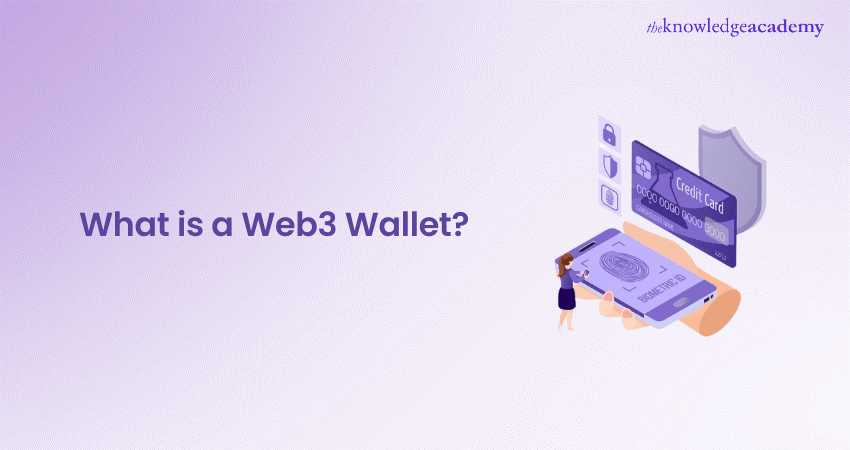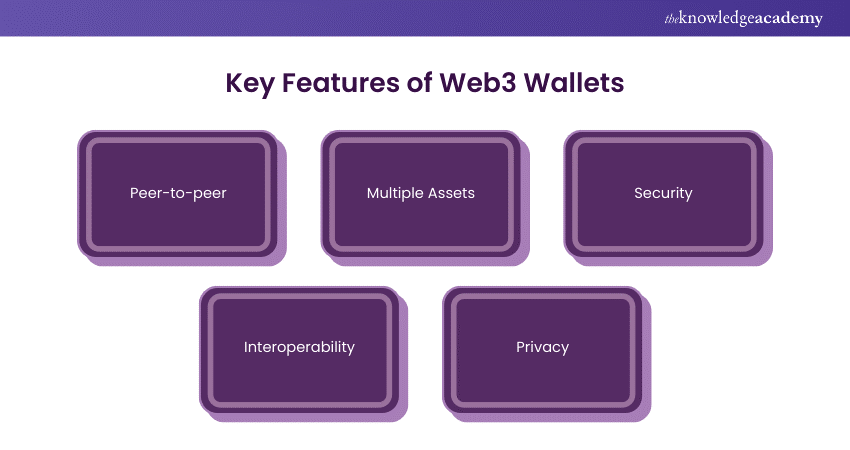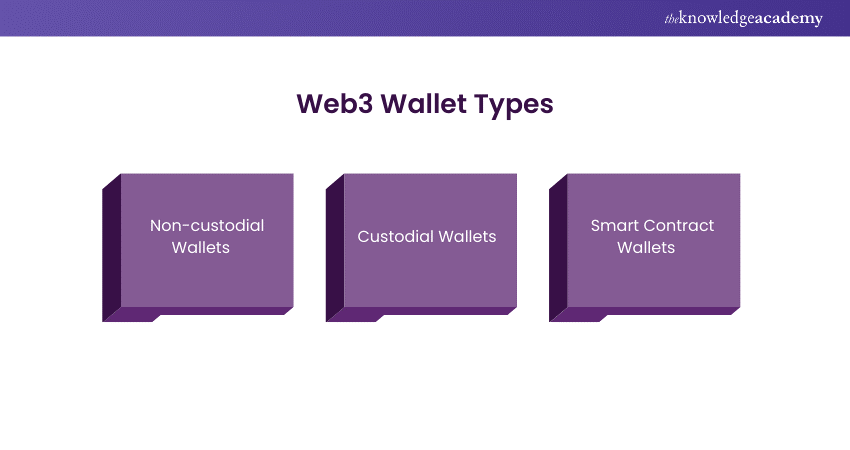We may not have the course you’re looking for. If you enquire or give us a call on 01344203999 and speak to our training experts, we may still be able to help with your training requirements.
Training Outcomes Within Your Budget!
We ensure quality, budget-alignment, and timely delivery by our expert instructors.

Web3 Wallets are advanced digital tools designed to interact with decentralized applications (dApps) and manage digital assets within the evolving Web3 landscape, which prioritizes decentralization and user control. These wallets enable users to securely store and manage cryptocurrencies, non-fungible tokens (NFTs), and other digital assets while providing seamless access to blockchain networks.
Unlike traditional wallets, Web3 wallets empower users with self-custody of their private keys, granting them full control over their assets without the need for third-party intermediaries. This will examine Web3 Wallet's key features, types, and how it works. Ready to take charge of your digital belongings with unparalleled security.
Table of Contents
1) What is a Web3 Wallet?
2) Key Features of Web3 Wallets
3) Types of Web3 Wallet
4) How Web3 Wallets Work?
5) How to use a Web3 Wallet?
6) Future of Web3 Wallets
7) Conclusion
What is a Web3 Wallet?
A Web3 Wallet is a digital tools that allows users to interact with decentralised applications (dApps) on Blockchain Networks. Unlike traditional wallets that manage fiat currencies and centralised digital assets, Web3 Wallets handle cryptocurrencies and tokens native to Blockchain ecosystems. These wallets enable individuals to interact directly with the Blockchain, conduct transactions, and utilise decentralised services without requiring intermediaries.
Web3 Wallets works on the principles of decentralisation and user control. By securely keeping private keys on their devices, users have complete power over their digital assets, ensuring privacy and security. These wallets allow for various tasks, from basic transactions to more advanced functions like staking and joining in decentralised governance. This direct interaction with Blockchain Technology marks a crucial shift from conventional financial systems, providing a transparent and open ecosystem for managing digital assets.
Key Features of Web3 Wallets
Web3 Wallets provide a variety of features that make them vital for interacting with Blockchain Networks. Key features include:

1) Peer-to-peer: Web3 Wallets allow direct user transactions via Blockchain Networks, eradicating the need for intermediaries like banks or payment platforms.
2) Multiple Assets: These wallets support various Blockchain Networks and applications, allowing users to handle numerous digital assets, such as cryptocurrencies and NFTs. They enable users to manage everything from a single interface without switching between different wallets.
3) Security: Web3 Wallets employ solid encryption to safeguard private keys, protecting them from hackers and other third-party threats.
4) Interoperability: They can interact flawlessly with other Web3 applications, enabling users to easily interact with decentralised exchanges, marketplaces, and other Blockchain-based services.
5) Privacy: Web3 Wallets do not need users to share personal data with third-party providers, allowing greater control over digital assets and personal data.
Learn cutting-edge Development techniques with our App & Web Development Training - Join now!
Types of Web3 Wallet
Web3 Wallets are available in various types, each with unique features and advantages. Let’s explore these types in detail:

1) Non-custodial Wallets
A non-custodial wallet comes with a private key facility and gives users full control over their assets. These wallet types are best known for offering solid security and improved privacy. Some of the renowned non-custodial wallets include Trust Wallet and MetaMask. Using these wallets, users can communicate directly with each other over Blockchain Networks. However, the individual can lose access to the data in case of losing the private key.
2) Custodial Wallets
Third-party service providers handle custodial wallets. The service provider stores and protects users' private keys. This kind of wallet offers both convenience and user-friendly features. Famous examples include platforms such as Coinbase and Binance. If users forget their login credentials, they can retrieve their funds. Nevertheless, this totally depends on the security protocols implemented by the provider. Custodial Wallets may be more vulnerable to hacking and security breaches.
3) Smart Contract Wallets
Smart Contract Wallets leverage Blockchain's ability to perform programs. They streamline transactions and offer enhanced options like multi-signature security. Users can set conditions for transactions, increasing security and functionality. Smart Contract Wallets can seamlessly engage with various dApps. Examples of it include Argent and Gnosis Safe. These wallets are perfect for users seeking advanced security and automation. They offer a balance of user control and automated features.
Master the digital currency revolution with our Bitcoin and Cryptocurrency Course – Sign up now!
How Web3 Wallets Work?
Web3 Wallets have gained immense popularity with the advancement of Cryptocurrency and Blockchain. These wallets store assets securely over the Blockchain Networks. Let’s see how it does so:
1) Generating and Managing Private Keys
A critical role of Web3 Wallets is securely hoarding private keys. Utilising sophisticated algorithms, these keys authenticate transactions on the Blockchain. When a user creates a Web3 Wallet, it produces two keys: A public key for receiving transactions and a private key for signing transactions and verifying asset ownership.
Guaranteeing the safety of private keys is vital, as anyone with access can control the corresponding assets. Web3 Wallets use advanced encryption methods to safeguard private keys. Some wallets offer additional security measures like multi-factor authentication and biometric verification to prevent unauthorised access.
2) Engaging With Blockchain Networks
Once users set up a Web3 Wallet and generate private keys, they can interact with Blockchain Networks. This includes transferring and receiving digital assets and interacting with Smart Contracts. To finish a transaction, input the recipient's public address and the amount to send.
The wallet demands your private key to sign the transaction and sends it to the Blockchain for verification. Web3 Wallets update their balance by recording incoming transactions on the public ledger, thus receiving digital assets.
3) Enabling Transactions and Smart Contract Functionality
Apart from sending and receiving assets, Web3 Wallets can engage with Smart Contracts. These contracts can be executed independently as they possess an embedded code. The wallet facilitates smooth data transactions, verifies asset ownership, and triggers contract execution.
Smart Contracts have applications in decentralised finance, supply chain management, asset tokenisation, and identity verification. The scope of Web3 Wallet is increasing rapidly as more businesses adopt this new technology.
How to use a Web3 Wallet?
Web3 Wallet opens doors of possibilities for businesses. To benefit your business, let’s understand the step-by-step process for using Web3 Wallet.
1) Download and Install: Download and Install the Web3 Wallet of your choice. Some wallets are mobile based, while others are browser extensions.
2) Create a Wallet: Once installed, you need to create a Web3 Wallet. If you wish to import wallet data, you can use a private key with a seed phrase.
3) Secure the Wallet: Always generate a strong password for your new wallet using a sequence of words (seed phrase). The seed phrase is your recovery key. So, please don’t lose it.
4) Receive a Public Address: Once your wallet is secured, you can view your public address. It’s a unique identifier that facilitates the transfer of Cryptocurrencies. Think of it as an email address for receiving crypto transactions.
5) Transaction of Digital Assets: Your wallet is set to send and receive assets over the Blockchain Network. You can allot your public address to receive payments or view asset balances.
Future of Web3 Wallets
With the advancement of Blockchain Technology, Web3 Wallets will play a vital role in digital financial infrastructure. As the digital asset industry grows, businesses must ensure these wallets are user-friendly to assist new users.
Web3 Wallets represent a significant advancement in digital transactions and ownership. Circle's Programmable Wallets offer users increased control, enhanced security, and seamless integration with current platforms.
If your company wants to integrate Web3 Wallets, you can explore a wallet-as-a-service product called Programmable Wallets. As part of Web3 Services, it enables you to incorporate secure wallets into your application easily. It effortlessly onboards users and manage increased transactions smoothly.
Conclusion
We hope you grasp insights from what is a Web3 Wallet and how it securely stores your digital assets. It also enables direct engagement with decentralised applications in the Blockchain ecosystem. Web3 Wallet has already brought a significant shift in the lives of users who wish to have full control of their digital assets. You, too, can step forward and embrace this new technology to secure your digital future.
Kickstart your Web3 career with our Web3 Professional Certification Training Course today!
Frequently Asked Questions

New users may find Web3 a little challenging. Other disadvantages of Web3 include higher transaction fees and a lack of regulatory oversight like conventional systems.

The decentralised framework of Web3 reduces the need for a traditional banking system, as it offers users full control.

Yes, Web3 Wallets are fully secure, as they possess advanced encryption methods. However, losing your private key means losing access to your valuable assets.

The Knowledge Academy takes global learning to new heights, offering over 30,000 online courses across 490+ locations in 220 countries. This expansive reach ensures accessibility and convenience for learners worldwide.
Alongside our diverse Online Course Catalogue, encompassing 17 major categories, we go the extra mile by providing a plethora of free educational Online Resources like News updates, Blogs, videos, webinars, and interview questions. Tailoring learning experiences further, professionals can maximise value with customisable Course Bundles of TKA.

The Knowledge Academy’s Knowledge Pass, a prepaid voucher, adds another layer of flexibility, allowing course bookings over a 12-month period. Join us on a journey where education knows no bounds.

The Knowledge Academy offers various App & Web Development Training, including the Web3 Professional Certification Training Course, and Web3 Professional Certification Training Course in Virtual. These courses cater to different skill levels and provide comprehensive insights into What is Web3.
Our Programming & DevOps Blogs cover a range of topics related to Blockchain, offering valuable resources, best practices, and industry insights. Whether you are a beginner or looking to advance your Programming & DevOps Skills, The Knowledge Academy's diverse courses and informative blogs have got you covered.
Upcoming Programming & DevOps Resources Batches & Dates
Date
 Web3 Professional Certification Training Course
Web3 Professional Certification Training Course
Fri 29th Nov 2024
Fri 7th Feb 2025
Fri 4th Apr 2025
Fri 6th Jun 2025
Fri 8th Aug 2025
Fri 3rd Oct 2025
Fri 5th Dec 2025







 Top Rated Course
Top Rated Course



 If you wish to make any changes to your course, please
If you wish to make any changes to your course, please


